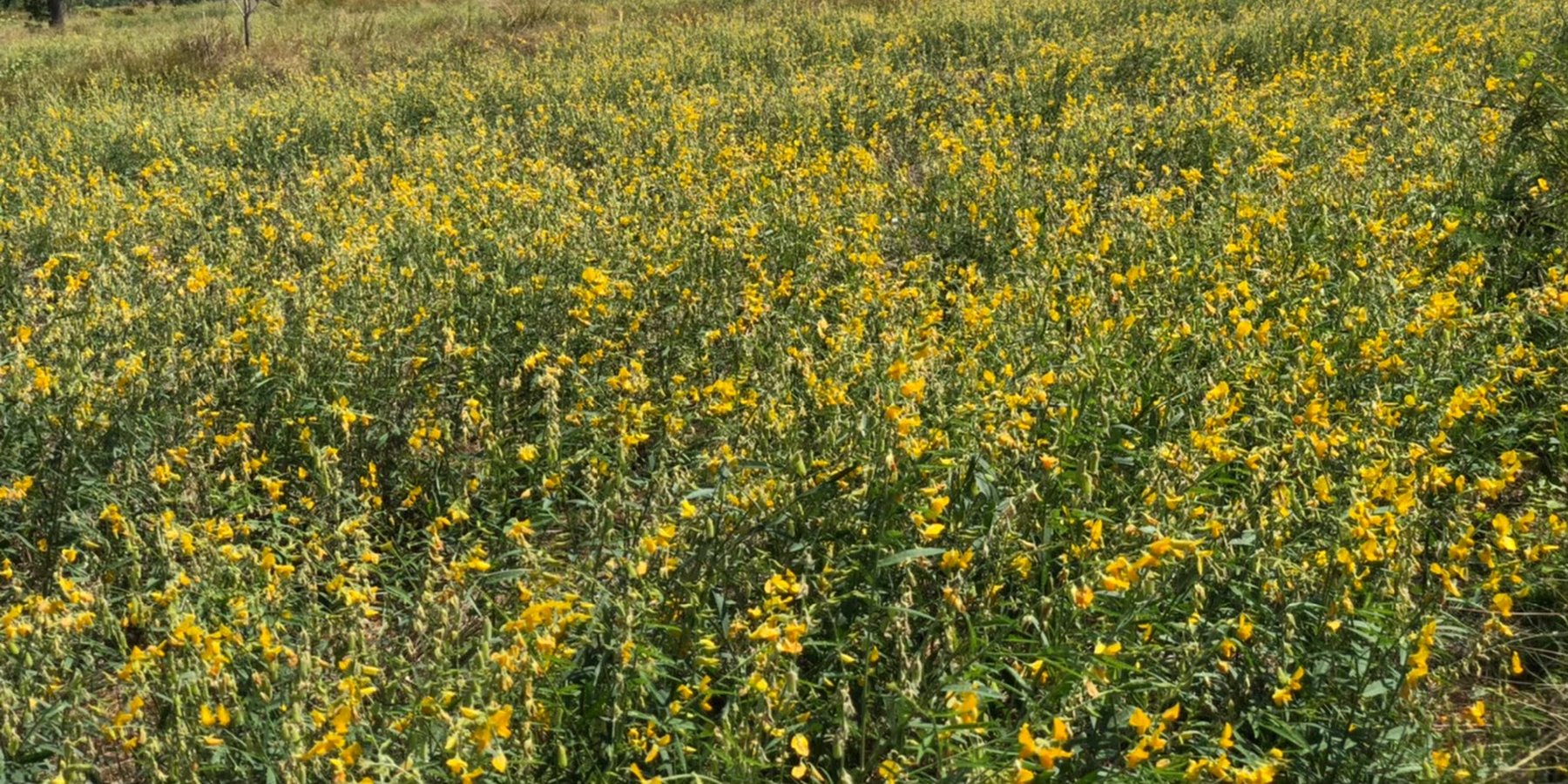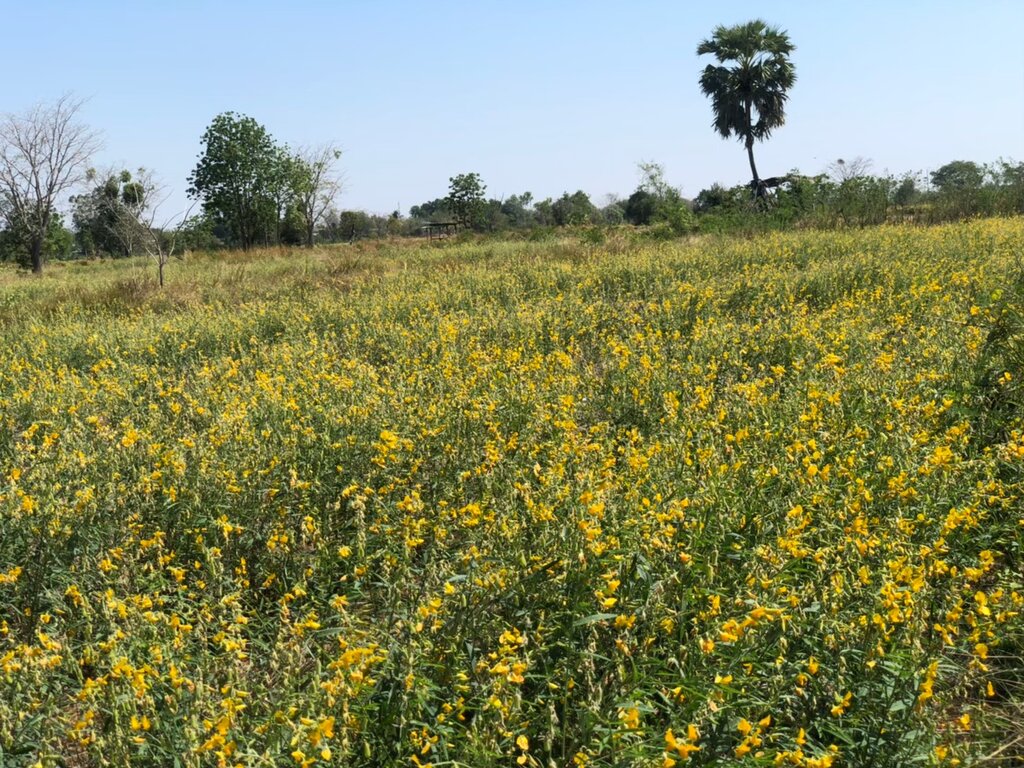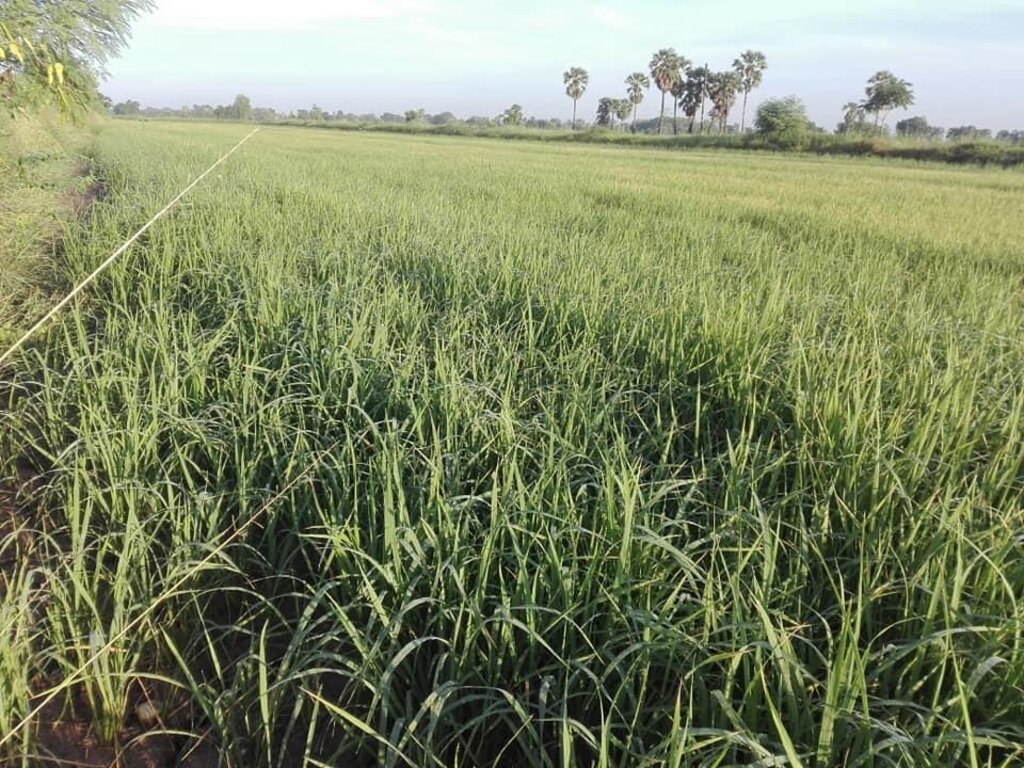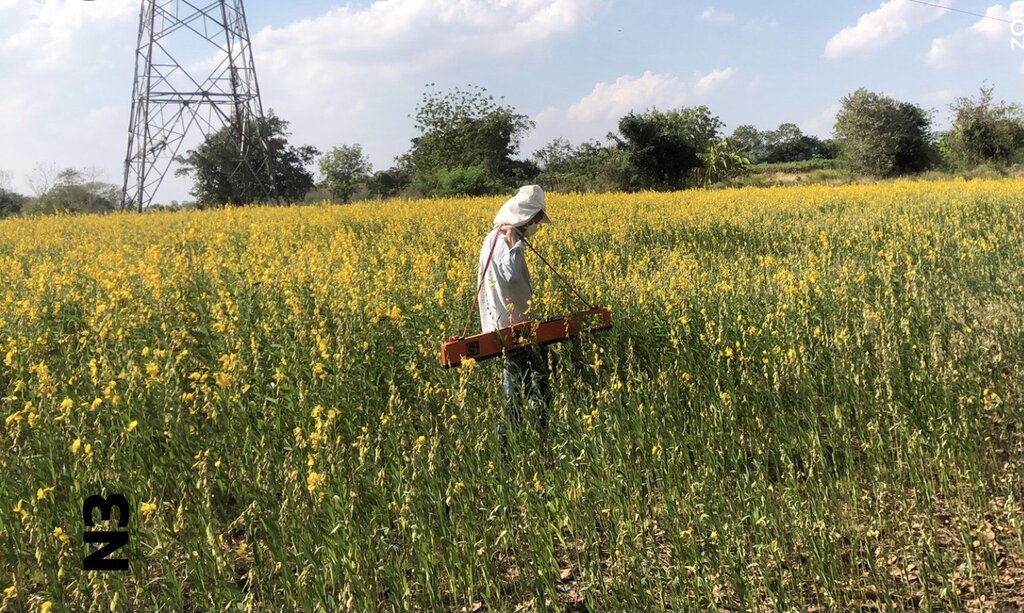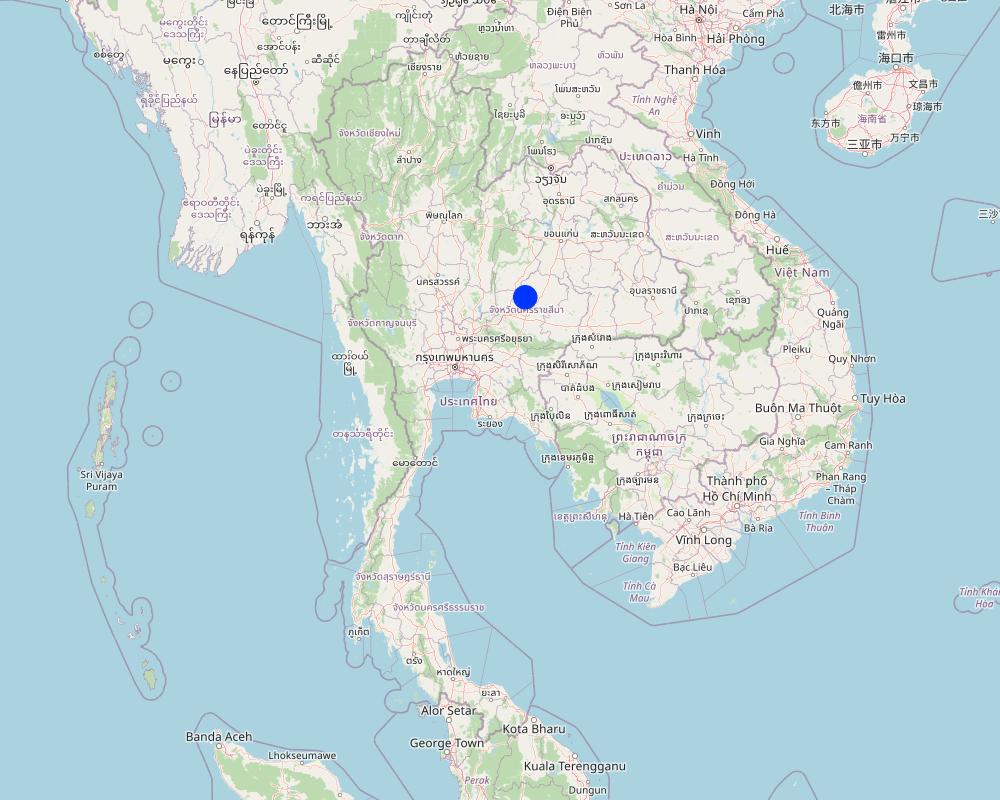SUNN HEMP AS A SOIL AMENDMENT AND FOR MITIGATION OF SALINITY [ប្រទេសថៃ]
- ការបង្កើត៖
- បច្ចុប្បន្នភាព
- អ្នកចងក្រង៖ Laksamee Mettpranee
- អ្នកកែសម្រួល៖ –
- អ្នកត្រួតពិនិត្យច្រើនទៀត៖ William Critchley, Rima Mekdaschi Studer, Joana Eichenberger
technologies_7274 - ប្រទេសថៃ
ពិនិត្យមើលគ្រប់ផ្នែក
ពង្រីកមើលទាំងអស់ បង្រួមទាំងអស់1. ព័ត៌មានទូទៅ
1.2 ព័ត៌មានលម្អិតពីបុគ្គលសំខាន់ៗ និងស្ថាប័នដែលចូលរួមក្នុងការវាយតម្លៃ និងចងក្រងឯកសារនៃបច្ចេកទេស
បុគ្គលសំខាន់ម្នាក់ (ច្រើននាក់)
អ្នកប្រើប្រាស់ដី:
Siangsunthia Mana
ប្រទេសថៃ
Compiler:
co-compiler:
Raksasarp Pithcanun
Land Development Department
ប្រទេសថៃ
co-compiler:
reviewer:
reviewer:
ឈ្មោះគម្រោងដែលបានចងក្រងឯកសារ/ វាយតម្លៃលើបច្ចេកទេស (បើទាក់ទង)
Decision Support for Mainstreaming and Scaling out Sustainable Land Management (GEF-FAO / DS-SLM)ឈ្មោះអង្គភាពមួយ (ច្រើន) ដែលបានចងក្រងឯកសារ/ វាយតម្លៃបច្ចេកទេស (បើទាក់ទង)
Land Development Department (Land Development Department) - ប្រទេសថៃឈ្មោះអង្គភាពមួយ (ច្រើន) ដែលបានចងក្រងឯកសារ/ វាយតម្លៃបច្ចេកទេស (បើទាក់ទង)
Centre of Excellence for Soil Research in Asia (CESRA)1.3 លក្ខខណ្ឌទាក់ទងទៅនឹងការប្រើប្រាស់ទិន្នន័យដែលបានចងក្រងតាមរយៈ វ៉ូខេត
អ្នកចងក្រង និង(បុគ្គលសំខាន់ៗ)យល់ព្រមទទួលយកនូវលក្ខខណ្ឌនានាទាក់ទងទៅនឹងការប្រើប្រាស់ទិន្នន័យដែលបានចងក្រងតាមរយៈវ៉ូខេត:
បាទ/ចា៎
1.4 សេចក្តីប្រកាសស្តីពីចីរភាពនៃការពណ៌នាពីបច្ចេកទេស
តើបច្ចេកទេសដែលបានពណ៌នានេះមានបញ្ហាដែលផ្តោតលើការធ្លាក់ចុះគុណភាពដី, បើដូច្នេះវាមិនអាចត្រូវបានប្រកាសថាជាបច្ចេកទេសនៃការគ្រប់គ្រងប្រកបដោយចីរភាពទេ?
ទេ
1.5 ការយោងទៅលើកម្រងបញ្ជីសំណួរ (មួយ ឬច្រើន) នៃវិធីសាស្ត្រផ្សព្វផ្សាយ SLM (ដែលបានចងក្រងដោយទស្សនៈពិភពលោកស្តីពីវិធីសាស្ត្រ និងបច្ចេកទេសងអភិរក្ស WOCAT)
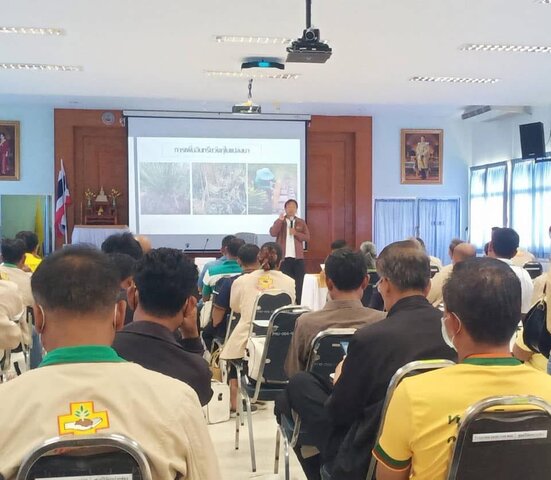
EXTENSION OF SUNN HEMP AS A SOIL AMENDMENT … [ប្រទេសថៃ]
An outreach programme aims to educate farmers about the benefits of ploughing rice stubble into the soil and incorporating green manure crops such as sunn hemp - as well as other sustainable practices. Groups of farmers are formed, and they are assisted by various organisations including the Land Development Department …
- អ្នកចងក្រង៖ Laksamee Mettpranee
2. ការពណ៌នាពីបច្ចេកទេស SLM
2.1 ការពណ៌នាដោយសង្ខេបពីបច្ចេកទេស
និយមន័យបច្ចេកទេស:
Sunn hemp (Crotalaria juncea) has been promoted by the Land Development Department as a green manure plant with the objectives of increasing soil organic matter, improving soil fertility and reducing salinity levels.
2.2 ការពណ៌នាលម្អិតពីបច្ចេកទេស
ការពណ៌នា:
The Northeast of Thailand has the largest area dedicated to rice production in the country. However, the average yield per hectare remains low. Here, rice production heavily depends on rainfall, but distribution is inconsistent. Additionally, soil fertility is low, with a rapid decline in soil organic matter (SOM). Another significant threat to productivity in this area is salinity, with 17% of the rice production area affected.
The Land Development Department (LDD) of the Ministry of Agriculture and Cooperatives has promoted the use of soil amendments, such as green manure plants - including sunn hemp (Crotalaria juncea) - to enhance organic matter and restore soil fertility under saline conditions. Green manures are ploughed under, and incorporated into the soil to achieve their effect.
In the Non Thai district of Nakhon Ratchasima province, farmers face water shortages during the dry season, as the area lies outside the irrigation zone. Farmers, along with officers from the Land Development Department, have worked to increase SOM in degraded soils through knowledge transfer. Volunteer soil doctors and local farmers have adopted technologies that combine SOM improvement with soil and water conservation measures.
One notable example is Mr. Mana Siangsuthia: since 1997, he has collaborated with LDD officers, receiving beneficial microorganisms (PD microorganisms), green manure plants, vetiver grass, and water resources for his paddy fields. He has implemented LDD guidelines to develop his 1.12 hectare rice plot. Previously, this land was unproductive due to soil degradation caused by long-term monoculture of industrial crops and excessive use of synthetic fertilizers.
Fermented bio-extracts from banana shoots and chemical fertilizers were applied according to recommended guidelines. In 2004, rice yields averaged 1,125–1,550 kg/ha. Continuous implementation of these practices raised yields to 2,500 kg/ha by 2011. Over 16 years, using sunn hemp as a soil amendment significantly improved soil aggregate stability and reduced salinity. This success led to a shift towards natural agriculture practices in 2013, where chemical fertilizers were no longer used.
Farmers in the area now employ weather observation techniques and efficient water management strategies during dry spells. Green manure plants are sown every two years, complemented by the cultivation of salt-tolerant rice varieties, which also exhibit drought and pest resistance. These practices have resulted in rice yields of 3,125–3,750 kg/ha.
After rice harvesting, rice straw and stubble are ploughed in together with banana shoot PD 2 bio-extract. After approximately 2 weeks of decomposition, sunn hemp is sown at the rate of 31.25 kg/ha. When sunn hemp reaches 120 days, its seeds are collected. Then sunn hemp stems of around 1.2 meters height are ploughed in order to obtain more biomass.
Water conservation remains a focus in the cultivation area. During the rainy season, excess rainwater is stored for use during dry periods. Additionally, farmers employ techniques to wash salt from the soil surface into drainage channels. Water quality is enhanced using fermented bio-extracts, ensuring adequate water for dry-season cultivation.
2.3 រូបភាពនៃបច្ចេកទេស
2.5 ប្រទេស/តំបន់/ទីតាំងកន្លែង ដែលបច្ចេកទេសត្រូវបានអនុវត្ត និងបានគ្រប់ដណ្តប់ដោយការវាយតម្លៃនេះ
ប្រទេស:
ប្រទេសថៃ
តំបន់/រដ្ឋ/ខេត្ត:
Nakhonratchasima
បញ្ជាក់បន្ថែមពីលក្ខណៈនៃទីតាំង:
Moo 5, Ban Kok Phrom, Non Thai sub-district, Non Thai district
បញ្ជាក់ពីការសាយភាយនៃបច្ចេកទេស:
- ត្រូវបានផ្សព្វផ្សាយត្រឹមតំបន់មួយ
ប្រសិនបើបច្ចេកទេសត្រូវបានសាយភាយពាសពេញតំបន់ណាមួយ បញ្ជាក់ទំហំផ្ទៃដីអនុវត្តន៍ (គិតជា គ.ម2):
11200,0
តើបច្ចេកទេស (មួយ ឬច្រើន) ទាំងនោះស្ថិតនៅក្នុងតំបន់ការពារជាអចិន្ត្រៃយ៍ណាមួយដែរឬទេ?
ទេ
Map
×2.6 កាលបរិច្ឆេទនៃការអនុវត្ត
បង្ហាញឆ្នាំនៃការចុះអនុវត្ត:
1999
ប្រសិនបើមិនច្បាស់ឆ្នាំ សូមបញ្ជាក់កាលបរិច្ឆេទដែលប្រហាក់ប្រហែល:
- 10-50 ឆ្នាំ
2.7 ការណែនាំពីបច្ចេកទេស
សូមបញ្ជាក់តើបច្ចេកទេសត្រូវបានណែនាំឱ្យអនុវត្តដោយរបៀបណា:
- តាមរយៈការបង្កើតថ្មីរបស់អ្នកប្រើប្រាស់ដី
- តាមរយៈគម្រោង / អន្តរាគមន៍ពីខាងក្រៅ
មតិយោបល់ (ប្រភេទនៃគម្រោង ។ល។):
The technology arises from land users’ innovation and is supported by external interventions and government agencies that acknowledge the value of technology to the community by providing resources, funding and supporting research and development.
3. ចំណាត់ថ្នាក់នៃបច្ចេកទេស SLM
3.1 គោលបំណងចម្បង (១ ឬច្រើន) នៃបច្ចេកទេសនេះ
- ធ្វើឱ្យប្រសើរឡើងនូវផលិតកម្ម
- កាត់បន្ថយ, បង្ការ, ស្តារឡើងវិញនូវការធ្លាក់ចុះគុណភាពដី
- អភិរក្សប្រព័ន្ធអេកូឡូស៊ី
- អភិរក្ស/ធ្វើឱ្យប្រសើរឡើងជីវចម្រុះ
- បង្កើតផលប្រយោជន៍សេដ្ឋកិច្ច
3.2 ប្រភេទដីប្រើប្រាស់មួយប្រភេទ (ច្រើនប្រភេទ) ដែលបានអនុវត្តបច្ចេកទេស
ដីប្រើប្រាស់ចម្រុះនៅលើដីតែមួយ:
ទេ

ដីដាំដំណាំ
- ដំណាំប្រចាំឆ្នាំ
- sunhemp - rice
ចំនួនសារដែលដាំដំណាំក្នុងមួយឆ្នាំ:
- 1
តើជាការអនុវត្តន៍ដំណាំចន្លោះ?
ទេ
តើជាការអនុវត្តន៍ដំណាំវិលជុំ?
បាទ/ចា៎
បើបាទ/ច៎ា សូមបញ្ជាក់:
Rice and sunn hemp
3.3 បន្ទាប់ពីអនុវត្តបច្ចេកទេស តើដីប្រើប្រាស់មានការប្រែប្រួលដែររឺទេ?
បន្ទាប់ពីអនុវត្តបច្ចេកទេស តើដីប្រើប្រាស់មានការប្រែប្រួលដែររឺទេ?
- បាទ/ច៎ា (សូមបំពេញសំណួរខាងក្រោមពីស្ថានភាពដីប្រើប្រាស់មុនពេលអនុវត្តបច្ចេកទេស)
ដីប្រើប្រាស់ចម្រុះនៅលើដីតែមួយ:
ទេ

ដីដាំដំណាំ
- ដំណាំប្រចាំឆ្នាំ
- sunhemp-rice
តើជាការអនុវត្តន៍ដំណាំចន្លោះ?
ទេ
តើជាការអនុវត្តន៍ដំណាំវិលជុំ?
ទេ
3.4 ការផ្គត់ផ្គង់ទឹក
ការផ្គត់ផ្គង់ទឹកនៅកន្លែងអនុវត្តបច្ចេកទេស:
- ទឹកភ្លៀង និងប្រព័ន្ធស្រោចស្រព
មតិយោបល់:
Rainfed lowland rice can be supported by small ponds for irrigation.
3.5 ក្រុម SLM ដែលបច្ចេកទេសស្ថិតនៅក្នុង
- ធ្វើឱ្យប្រសើរឡើងគម្របដី/ ដំណាំគម្របដី
- ការគ្រប់គ្រងជីជាតិដីតាមបែបចម្រុះ
3.6 វិធានការ SLM ដែលបញ្ចូលនូវបច្ចេកទេស

វិធានការក្សេត្រសាស្ត្រ
- A1: ដំណាំ/គម្របដី
- A2: សារធាតុសរីរាង្គ/ជីជាតិដី
3.7 កំណត់ប្រភេទនៃការធ្លាក់ចុះគុណភាពដីសំខាន់ៗដែលបច្ចេកទេសនេះបានដោះស្រាយ

ការធ្លាក់ចុះសារធាតុគីមីក្នុងដី
- Cs: សារធាតុប្រៃ/អាល់កាឡាំង

ការធ្លាក់ចុះជីវសាស្ត្រនៃដី
- Bc: ការថយចុះនូវគម្របរុក្ខជាតិ
- Bs: សមាសភាពដែលមានគុណភាពនិងប្រភេទសត្វ/ការថយចុះនូវជីវចម្រុះ
3.8 ការពារ កាត់បន្ថយ ឬស្តារឡើងវិញនៃការធ្លាក់ចុះគុណភាពដី
បញ្ជាក់ពីគោលដៅរបស់បច្ចេកទេស ដែលផ្តោតទៅការធ្លាក់ចុះគុណភាពដី:
- ការការពារការធ្លាក់ចុះគុណភាពដី
- ការជួសជុល/ ស្តារឡើងវិញនៃឱនភាពដីធ្ងន់ធ្ងរ
4. បច្ចេកទេសជាក់លាក់ សកម្មភាពអនុវត្ត ធាតុចូល និងថ្លៃដើម
4.1 គំនូសបច្ចេកទេសនៃបច្ចេកទេសនេះ
លក្ខណៈពិសេសនៃបច្ចេកទេស (ទាក់ទងនឺងគំនូរបច្ចេកទេស):
Above shows irrigation ponds associated with rice production. Below is the annual planting calendar where sunn hemp is used.
ឈ្មោះអ្នកនិពន្ធ:
Wanaporn polsang
កាលបរិច្ឆេទ:
02/08/2020
លក្ខណៈពិសេសនៃបច្ចេកទេស (ទាក់ទងនឺងគំនូរបច្ចេកទេស):
Methods of planting Crotalaria juncea (sunn hemp) to be used as a green manure plant in areas with saline soil are as follows:
1. The period of planting is during February to April whereby planting is conducted in between after harvesting rice yields so that Crotalaria juncea ( Sunn hemp) can thrive and give out high biomass.
2. Plough and ferment rice stubble together with using PD 2 bio-extracts to create bacterial process in the soil accelerating decomposition taking about 2 weeks. Then, sunn hemp is sown at the rate of 31.25 kg/ha in the soil with appropriate moisture throughout the plot in order to bring about regular germination.
3. Plowing up and over to cover sunn hemp stubble at the age of 120 days after collecting seeds of sunn hemp whereby the stem of sunn hemp is at the average of more than 1.2 meters resulting in obtaining more biomass. After that, during the period of preparing the area for planting rice, rice can be sowed in May or when there is enough amount of water.
4. When the seeds are kept to be used in the following season, the seed coat of sunn hemp is used as material incorporated with soil to make compost for soil amendment in growing vegetables.
ឈ្មោះអ្នកនិពន្ធ:
Wanaporn polsang
កាលបរិច្ឆេទ:
02/08/2020
4.2 ព័ត៌មានទូទៅដែលពាក់ព័ន្ធនឹងការគណនាធាតុចូល និងថ្លៃដើម
កំណត់របៀបនៃការគណនាថ្លៃដើម និងធាតុចូល:
- ក្នុងតំបន់អនុវត្តបច្ចេកទេស
កំណត់ទំហំ និងឯកត្តាផ្ទៃដី:
1.12 ha
បើសិនប្រើឯកតាតាមតំបន់ សូមបញ្ជាក់តម្លៃបម្លែងវាទៅជាហិកតា (ឧ. 1 ហិកតា = 2.47 អា)៖ 1 ហិកតា =:
1 ha=6.25 rai
កំណត់រូបិយប័ណ្ណសម្រាប់ថ្លៃដើម:
- ដុល្លារ
បើពាក់ព័ន្ធសូមកំណត់អត្រាប្តូរប្រាក់ពីដុល្លាទៅរូបិយប័ណ្ណតំបន់ (ឧ. 1 ដុល្លារ = 79.9 រៀលនៃរូបិយប័ណ្ណប្រេស៊ីល) ៖ 1 ដុល្លារ =:
34,0
4.5 សកម្មភាពថែទាំ
| សកម្មភាព | ពេលវេលា/ ភាពញឹកញាប់ | |
|---|---|---|
| 1. | Planting is conducted in between after harvesting rice yields so that Crotalaria juncea ( Sunn hemp) can thrive and give out high biomass. | February-April |
| 2. | Plough and ferment rice stubble together with using PD 2 bio-extracts to create bacterial process in the soil accelerating decomposition taking about 2 weeks. Then, sunn hemp is sowed at the rate of 31.25 kg/ha in the soil with appropriate moisture throughout the plot in order to bring about regular germination. | February-April |
| 3. | Ploughing up and over to cover sunn hemp stubble at the age of 120 days after collecting seeds of sunn hemp whereby the stem of sunn hemp is at the average of more than 1.2 meters resulting in obtaining more biomass. After that, during the period of preparing the area for planting rice, rice can be sowed in May or when there is enough amount of water. | May-August |
| 4. | When the seeds are kept to be used in the following season, the seed coat of sunn hemp is used as material incorporated with soil to make compost for soil amendment in growing vegetables. | May-August |
មតិយោបល់:
Ban Kok Phrom Village, Non Thai sub-district, Non Thai district, Nakhon Ratchasima province
4.6 កំណត់ថ្លៃដើមសម្រាប់ការថែទាំ/ សកម្មភាពរបស់បច្ចេកទេស (ក្នុងរយៈពេលមួយឆ្នាំ)
| បញ្ជាក់ពីធាតុចូល | ឯកតា | បរិមាណ | ថ្លៃដើមក្នុងមួយឯកតា | ថ្លៃធាតុចូលសរុប | % នៃថ្លៃដើមដែលចំណាយដោយអ្នកប្រើប្រាស់ដី | |
|---|---|---|---|---|---|---|
| កម្លាំងពលកម្ម | Plow to prepare plots | Time | 1,0 | 14,71 | 14,71 | 100,0 |
| កម្លាំងពលកម្ម | Sow rice | Time | 1,0 | 17,65 | 17,65 | 100,0 |
| កម្លាំងពលកម្ម | Pump water | Time | 2,0 | 58,82 | 117,64 | 100,0 |
| កម្លាំងពលកម្ម | Harvest yield | Time | 1,0 | 183,82 | 183,82 | 100,0 |
| សម្ភារៈដាំដុះ | Rice seeds | Kilogram | 8,0 | 0,53 | 4,24 | 100,0 |
| ជី និងសារធាតុពុល | Weight | Liter | 40,0 | 0,29 | 11,6 | 100,0 |
| ជី និងសារធាតុពុល | Green Manure | Kilogram | 5,0 | 0,68 | 3,4 | 100,0 |
| ផ្សេងៗ | Oil costs for farm truck | Time | 1,0 | 58,82 | 58,82 | 100,0 |
| ថ្លៃដើមសរុបសម្រាប់ការថែទាំដំណាំតាមបច្ចេកទេស | 411,88 | |||||
| ថ្លៃដើមសរុបសម្រាប់ការថែទាំដំណាំតាមបច្ចេកទេសគិតជាដុល្លារ | 12,11 | |||||
ប្រសិនបើអ្នកប្រើប្រាស់ដីមិនមានថ្លៃដើម 100% សូមបញ្ជាក់ថានរណាដែលចំណាយថ្លៃដើមដែលនៅសល់:
The Land Development Department does not provide financial support but instead supports agricultural production inputs, such as green manure seeds and raw materials for compost production.
មតិយោបល់:
Calculation of costs and expenses
Expenses are calculated per areas using technology (Unit of size and area: 1.12 ha)
The currency used to calculate expenses with the unit as Baht
Exchange rate (to US. dollars) 1 US. Dollars = 34.0 Baht
Average wage in hiring labor per day is 8.82 USD
4.7 កត្តាសំខាន់បំផុតដែលមានឥទ្ធិពលដល់ការចំណាយ
ពណ៌នាពីកត្តាប៉ះពាល់ចម្បងៗទៅលើថ្លៃដើម:
1. Labour costs
2. Fuel costs
5. លក្ខណៈបរិស្ថានធម្មជាតិ និងមនុស្ស
5.1 អាកាសធាតុ
បរិមាណទឹកភ្លៀងប្រចាំឆ្នាំ
- < 250 មម
- 251-500 មម
- 501-750 មម
- 751-1,000 មម
- 1,001-1,500 មម
- 1,501-2,000 មម
- 2,001-3,000 មម
- 3,001-4,000 មម
- > 4,000 មម
តំបន់កសិអាកាសធាតុ
- មានភ្លៀងមធ្យម
5.2 សណ្ឋានដី
ជម្រាលជាមធ្យម:
- រាបស្មើ (0-2%)
- ជម្រាលតិចតួច (3-5%)
- មធ្យម (6-10%)
- ជម្រាលខ្ពស់បន្តិច (11-15%)
- ទីទួល (16-30%)
- ទីទួលចោត (31-60%)
- ទីទួលចោតខ្លាំង (>60%)
ទម្រង់ដី:
- ខ្ពង់រាប
- កំពូលភ្នំ
- ជម្រាលភ្នំ
- ជម្រាលទួល
- ជម្រាលជើងភ្នំ
- បាតជ្រលងភ្នំ
តំបន់តាមរយៈកម្ពស់ :
- 0-100 ម
- 101-500 ម
- 501-1,000 ម
- 1,001-1,500 ម
- 1,501-2,000 ម
- 2,001-2,500 ម
- 2,501-3,000 ម
- 3,001-4,000 ម
- > 4,000 ម
បញ្ជាក់ថាតើបច្ចេកទេសនេះត្រូវបានអនុវត្តន៍នៅក្នុង:
- មិនពាក់ព័ន្ធទាំងអស់
5.3 ដី
ជម្រៅដីជាមធ្យម:
- រាក់ខ្លាំង (0-20 សម)
- រាក់ (21-50 សម)
- មធ្យម (51-80 សម)
- ជ្រៅ (81-120 សម)
- ជ្រៅខ្លាំង (> 120 សម)
វាយនភាពដី (ស្រទាប់លើ):
- គ្រើម/ មានពន្លឺ (ខ្សាច់)
វាយនភាពដី (> 20 សម ស្រទាប់ក្នុង):
- មធ្យម (ល្បាយ, ល្បាប់)
សារធាតុសរីរាង្គនៅស្រទាប់ដីខាងលើ:
- មធ្យម (1-3%)
5.4 ទឹកដែលអាចទាញមកប្រើប្រាស់បាន និងគុណភាពទឹក
នីវ៉ូទឹកក្រោមដី:
ផ្ទៃខាងលើ
ទឹកលើដីដែលអាចទាញយកប្រើប្រាស់បាន:
ល្អ
គុណភាពទឹក (មិនបានធ្វើប្រត្តិកម្ម):
ទឹកសម្រាប់តែការធ្វើកសិកម្ម (ស្រោចស្រព)
គុណភាពទឹក គឺផ្តោតទៅលើ៖:
ទឹកលើផ្ទៃដី
តើមានបញ្ហាភាពទឹកប្រៃហូរចូលមកដែរឬទេ?
បាទ/ចា៎
តើទឹកជំនន់កំពុងកើតមាននៅតំបន់នេះដែររឺទេ?
ទេ
5.5 ជីវៈចម្រុះ
ភាពសម្បូរបែបនៃប្រភេទ:
- កម្រិតមធ្យម
ភាពសម្បូរបែបនៃទីជម្រក:
- កម្រិតមធ្យម
5.6 លក្ខណៈនៃអ្នកប្រើប្រាស់ដីដែលអនុវត្តបច្ចេកទេស
នៅមួយកន្លែង ឬពនេចរ :
- នៅមួយកន្លែង
ទីផ្សារនៃប្រព័ន្ធផលិតកម្ម:
- ពាក់កណ្តាលពាណិជ្ជកម្ម (ផ្គត់ផ្គង់ខ្លួនឯង/ ពាណិជ្ជកម្ម)
ចំណូលក្រៅកសិកម្ម:
- ច្រើនជាង 50% នៃចំណូល
កម្រិតជីវភាព:
- មធ្យម
ឯកជន ឬក្រុម:
- ធ្វើខ្លួនឯង/ គ្រួសារ
យេនឌ័រ:
- បុរស
អាយុរបស់អ្នកប្រើប្រាស់ដី:
- មនុស្សចាស់
5.7 ទំហំផ្ទៃដីជាមធ្យមនៃដីប្រើប្រាស់ដោយអ្នកប្រើប្រាស់ដី ក្នុងការអនុវត្តបច្ចេកទេស
- < 0.5 ហិកតា
- 0.5-1 ហិកតា
- 1-2 ហិកតា
- 2-5 ហិកតា
- 5-15 ហិកតា
- 15-50 ហិកតា
- 50-100 ហិកតា
- 100-500 ហិកតា
- 500-1,000 ហិកតា
- 1,000-10,000 ហិកតា
- > 10,000 ហិកតា
តើផ្ទៃដីនេះចាត់ទុកជាទំហំកម្រិតណាដែរ ខ្នាតតូច មធ្យម ឬខ្នាតធំ (ធៀបនឹងបរិបទតំបន់)?
- ខ្នាតតូច
5.8 ភាពជាម្ចាស់ដី កម្មសិទ្ធប្រើប្រាស់ដី និងកម្មសិទ្ធប្រើប្រាស់ទឹក
ភាពជាម្ចាស់ដី:
- ឯកជន មានកម្មសិទ្ធ
កម្មសិទ្ធិប្រើប្រាស់ដី:
- ឯកជន
តើកម្មសិទ្ធប្រើប្រាស់ដី គឺផ្អែកលើប្រព័ន្ធច្បាប់បែបបុរាណ?
បាទ/ចា៎
5.9 ការប្រើប្រាស់សេវាកម្ម និងហេដ្ឋារចនាសម្ព័ន្ធ
សុខភាព:
- មិនល្អ
- មធ្យម
- ល្អ
ការអប់រំ:
- មិនល្អ
- មធ្យម
- ល្អ
ជំនួយបច្ចេកទេស:
- មិនល្អ
- មធ្យម
- ល្អ
ការងារ (ឧ. ការងារក្រៅកសិដ្ឋាន):
- មិនល្អ
- មធ្យម
- ល្អ
ទីផ្សារ:
- មិនល្អ
- មធ្យម
- ល្អ
ថាមពល:
- មិនល្អ
- មធ្យម
- ល្អ
ផ្លូវ និងការដឹកជញ្ជូន:
- មិនល្អ
- មធ្យម
- ល្អ
ទឹកផឹក និងអនាម័យ:
- មិនល្អ
- មធ្យម
- ល្អ
សេវាកម្មហិរញ្ញវត្ថុ:
- មិនល្អ
- មធ្យម
- ល្អ
6. ផលប៉ះពាល់ និងការសន្និដ្ឋាន
6.1 ផលប៉ះពាល់ក្នុងបរិវេណអនុវត្តបច្ចេកទេសដែលកើតមាន
ផលប៉ះពាល់លើសេដ្ឋកិច្ចសង្គម
ផលិតផល
ផលិតកម្មដំណាំ
គុណភាពមុន SLM:
Being areas with saline soils with salt stain on the soil surface, yields per hectare
គុណភាពក្រោយ SLM:
Soil properties become better, the quantity of products increases
គុណភាពដំណាំ
គុណភាពមុន SLM:
Yields per hectare are low.
គុណភាពក្រោយ SLM:
The plants receive nutrients and the soil quality improves resulting in better product quality.
ការគ្រប់គ្រងដី
គុណភាពមុន SLM:
Factors and soil amendment materials are used continuously every year.
គុណភាពក្រោយ SLM:
Good soil properties make soil management for cultivation become easier.
មតិយោបល់/ ការបញ្ជាក់:
Using a questionnaire
ទឹកដែលអាចទាញមកប្រើប្រាស់បាន និងគុណភាពទឹក
ទឹកប្រើប្រាស់សម្រាប់ស្រោចស្រព
គុណភាពមុន SLM:
Rainwater is used for conducting agricultural farming.
គុណភាពក្រោយ SLM:
Water resources in the paddy field
គុណភាពទឹកស្រោចស្រព
គុណភាពមុន SLM:
Affected by salt water
គុណភាពក្រោយ SLM:
Water qualities are improved by using fermented bio-extracts.
មតិយោបល់/ ការបញ្ជាក់:
Salt meter
ចំណូល និងថ្លៃដើម
ការចំណាយលើធាតុចូលកសិកម្ម
គុណភាពមុន SLM:
A large quantity of factors and soil amendment materials were used
គុណភាពក្រោយ SLM:
Materials easily found in the area such as fermented extracts, green manure are used.
មតិយោបល់/ ការបញ្ជាក់:
Using a quetionnaire
ចំណូលក្នុងកសិដ្ឋាន
គុណភាពមុន SLM:
Low productivity
គុណភាពក្រោយ SLM:
Received higher quantity of rice products
មតិយោបល់/ ការបញ្ជាក់:
Using a quetionnaire
ផលប៉ះពាល់ទៅលើវប្បធម៌សង្គម
សន្តិសុខស្បៀង/ ភាពគ្រប់គ្រាន់ខ្លួនឯង
គុណភាពមុន SLM:
Yields not enough for consumption in the household
គុណភាពក្រោយ SLM:
Having the quantity of rice products for household consumption enough throughout the year accounting for 700 kg./year
មតិយោបល់/ ការបញ្ជាក់:
Using a quetionnaire
ស្ថានភាពសុខភាព
គុណភាពមុន SLM:
--
គុណភាពក្រោយ SLM:
Conducting natural farming by avoiding fertilizer and chemical application
មតិយោបល់/ ការបញ្ជាក់:
Using a questionnaire
ស្ថាប័នសហគមន៍
គុណភាពមុន SLM:
Study how to solve proStudy how to solve problems by themselvesblems by themselves
គុណភាពក្រោយ SLM:
Building interaction of farmers groups in the area based on consulting and mutual problem solving
ចំណេះដឹង SLM / ការធ្លាក់ចុះគុណភាពដី
គុណភាពមុន SLM:
There is no knowledge propagation.
គុណភាពក្រោយ SLM:
Farmers in the adjacent plot accept the technology and implement methods of soil management in their own areas.
ផលប៉ះពាល់ទៅលើអេកូឡូស៊ី
ដី
សំណើមដី
គុណភាពមុន SLM:
The soil is arid with flaky salt on the soil surface.
គុណភាពក្រោយ SLM:
There has been accumulation of organic matter and mulch keeps moistures and reduces water evaporation in the soil.
មតិយោបល់/ ការបញ្ជាក់:
Collect samples for laboratory testing.
វដ្តនៃសារធាតុចិញ្ចឹម/ការទទួលបាន
គុណភាពមុន SLM:
--
គុណភាពក្រោយ SLM:
Nutrients increase due to planting different crops such as sunn hemp and plowing up and over rice stubble.
មតិយោបល់/ ការបញ្ជាក់:
Collect samples for laboratory testing.
ភាពប្រៃ
គុណភាពមុន SLM:
Moisture in the soil was low. The soil was characterized by having flaky salt appearing on the soil surface.
គុណភាពក្រោយ SLM:
Salinity measured from the soil surface decreased. Organic matter and the number of microbes accumulating in the soil increased.
មតិយោបល់/ ការបញ្ជាក់:
Collect samples for laboratory testing.
សារធាតុសរីរាង្គដី/ការបូនក្រោមដី
គុណភាពមុន SLM:
--
គុណភាពក្រោយ SLM:
Organic matter from plowing up and over to cover rice stubble, green manure plants
មតិយោបល់/ ការបញ្ជាក់:
Collect samples for laboratory testing.
ជីវចម្រុះ៖ ដំណាំ, សត្វ
ភាពសម្បូរបែបនៃរុក្ខជាតិ
គុណភាពមុន SLM:
--
គុណភាពក្រោយ SLM:
Plant varieties which can be planted and grow in the area more such as rice, sunn hemp
មតិយោបល់/ ការបញ្ជាក់:
Observation
6.2 ផលប៉ះពាល់ក្រៅបរិវេណអនុវត្តបច្ចេកទេសដែលកើតមាន
ទឹកដែលអាចទាញមកប្រើប្រាស់បាន
គុណភាពមុន SLM:
Small-scale water resources
គុណភាពក្រោយ SLM:
Expansion of digging ponds resulting in more areas of water storage
6.3 ភាពប្រឈម និងភាពរួសនៃបច្ចេកទេសទៅនឹងការប្រែប្រួលអាកាសធាតុ និងគ្រោះអាកាសធាតុ/ គ្រោះមហន្តរាយ (ដែលដឹងដោយអ្នកប្រើប្រាស់ដី)
ការប្រែប្រួលអាកាសធាតុ
ការប្រែប្រួលអាកាសធាតុ
| រដូវកាល | កើនឡើង ឬថយចុះ | លក្ខណៈឆ្លើយតបនៃបច្ចេកទេសទៅនឹងការប្រែប្រួលអាកាសធាតុ | |
|---|---|---|---|
| សីតុណ្ហភាពប្រចាំឆ្នាំ | កើនឡើង | មធ្យម |
គ្រោះអាកាសធាតុ (មហន្តរាយ)
គ្រោះមហន្តរាយអាកាសធាតុ
| លក្ខណៈឆ្លើយតបនៃបច្ចេកទេសទៅនឹងការប្រែប្រួលអាកាសធាតុ | |
|---|---|
| រលកកម្តៅ | មធ្យម |
| រាំងស្ងួត | មធ្យម |
6.4 ការវិភាគថ្លៃដើម និងអត្ថប្រយោជន៍
តើផលចំណេញ និងថ្លៃដើមត្រូវបានប្រៀបធៀបគ្នាយ៉ាងដូចម្តេច (ទស្សនៈរបស់អ្នកប្រើប្រាស់ដី)?
រយៈពេលខ្លី:
ប៉ះពាល់តិចតួចបំផុត
រយៈពេលវែង:
ប៉ះពាល់តិចតួចបំផុត
តើផលចំណេញ និងការថែទាំ/ ជួសជុលត្រូវបានប្រៀបធៀបគ្នាយ៉ាងដូចម្តេច (ទស្សនៈរបស់អ្នកប្រើប្រាស់ដី)?
រយៈពេលខ្លី:
ប៉ះពាល់តិចតួចបំផុត
រយៈពេលវែង:
ប៉ះពាល់តិចតួចបំផុត
6.5 ការទទួលយកបច្ចេកទេស
- 11-50%
ក្នុងចំណោមគ្រួសារទាំងអស់ដែលបានអនុវត្តបច្ចេកទេស តើមានប៉ុន្មានគ្រួសារដែលចង់ធ្វើដោយខ្លួនឯង ដោយមិនទទួលបានសម្ភារៈលើកទឹកចិត្ត/ប្រាក់ឧបត្ថម្ភ?:
- 11-50%
មតិយោបល់:
The land users are responsible for covering the costs themselves. The Land Development Department provides support by supplying green manure seeds to demonstrate and test whether growing green manure crops can effectively improve saline soil.
6.6 ការបន្សុំា
តើថ្មីៗនេះ បច្ចេកទេសនេះត្រូវបានកែតម្រូវដើម្បីបន្ស៊ាំទៅនឹងស្ថានភាពប្រែប្រួលដែរឬទេ?
ទេ
6.7 ភាពខ្លាំង/ គុណសម្បត្តិ/ ឱកាសនៃបច្ចេកទេស
| ភាពខ្លាំង/ គុណសម្បត្តិ/ ឱកាសនៅកន្លែងរបស់អ្នកប្រើប្រាស់ដី |
|---|
| Farmers manage soil and water use integrated farming methods, leading to additional income opportunities |
| Farmers in the area are committed to overcoming challenges and limitation related to soil, water, and environmental conditions |
| ភាពខ្លាំង/ គុណសម្បត្តិ/ ឱកាស ទស្សនៈរបស់បុគ្គលសំខាន់ៗ |
|---|
| Support for forming farmer groups in the area to exchange knowledge on soil management for increasing crop yields and addressing local farming issues, as well as developin professions for community farmers. This includes promotiong the production of safe |
6.8 ភាពខ្សោយ/ គុណវិបត្តិ/ ហានិភ័យនៃបច្ចេកទេស និងវិធីសាស្ត្រដោះស្រាយ
| ភាពខ្សោយ/ គុណវិបត្តិ/ ហានិភ័យ ទស្សនៈរបស់អ្នកប្រើប្រាស់ដី | តើបច្ចេកទេសទាំងនោះបានដោះស្រាយបញ្ហាដូចម្តេច? |
|---|---|
| Quality problems of Sunn hemp seeds result in low germination rates. | Land Development Department officials inspect the quality of seeds before they are distributed to farmers. |
7. ឯកសារយោង និងវេបសាយ
7.1 វិធីសាស្ត្រ/ ប្រភពនៃព័ត៌មាន
- តាមការចុះទីវាល ការស្រាវជ្រាវនៅទីវាល
8
- ការសម្ភាសន៍ជាមួយអ្នកប្រើប្រាស់ដី
1
- ការសម្ភាសន៍ជាមួយអ្នកជំនាញ/ ឯកទេស
5
7.3 ការភ្ជាប់ទៅកាន់ព័ត៌មានពាក់ព័ន្ធលើប្រព័ន្ធអនឡាញ
ចំណងជើង/ ពណ៌នា:
Sustainable soil management practices in Asia
វេបសាយ:
https://e-library.ldd.go.th/library/Ebook/bib10906.pdf
ការតភ្ជាប់ និងម៉ូឌុល
ពង្រីកមើលទាំងអស់ បង្រួមទាំងអស់ការតភ្ជាប់

EXTENSION OF SUNN HEMP AS A SOIL AMENDMENT … [ប្រទេសថៃ]
An outreach programme aims to educate farmers about the benefits of ploughing rice stubble into the soil and incorporating green manure crops such as sunn hemp - as well as other sustainable practices. Groups of farmers are formed, and they are assisted by various organisations including the Land Development Department …
- អ្នកចងក្រង៖ Laksamee Mettpranee
ម៉ូឌុល
គ្មានម៉ូឌុល


